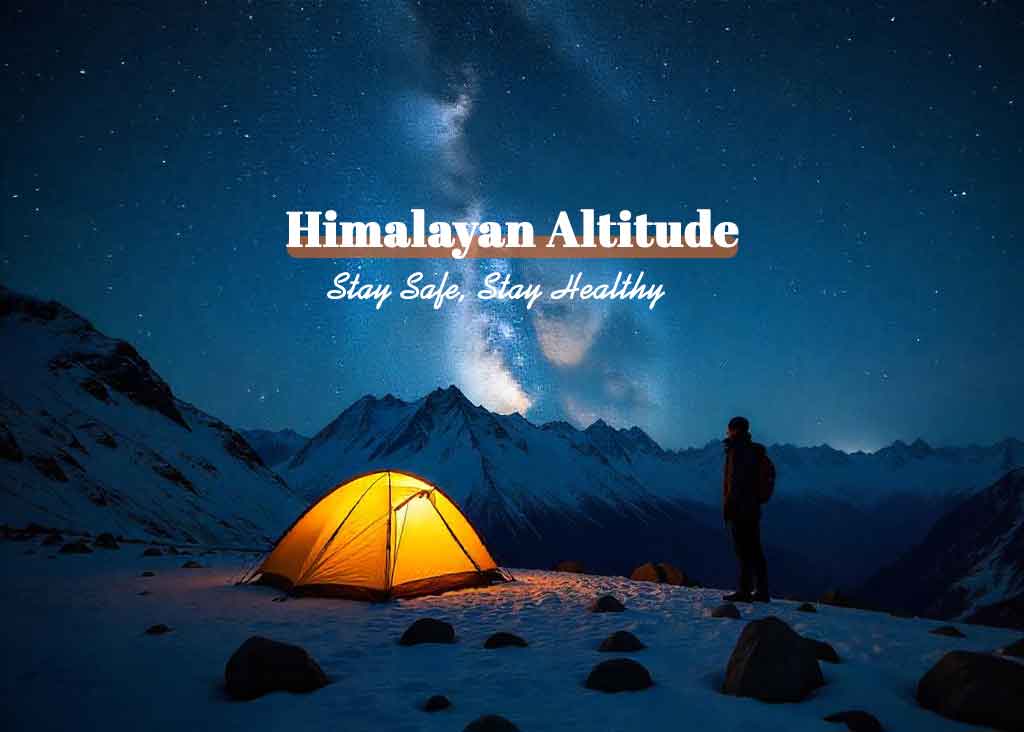Himalayan Altitude: Stay Safe, Stay Healthy

Exploring high-altitude locations in the majestic Himalayas is a dream for many adventurers. From captivating vistas to tranquil landscapes, the Himalayas offer unmatched beauty. However, altitudes above 2,500 meters come with challenges that require careful preparation for a safe and enjoyable journey. Here are precautions you should take when traveling to high-altitude locations in the Himalayas in India:
1. Acclimatization is Key
- Ascend gradually to allow your body to adjust to thinner air. Avoid climbing more than 500 meters a day once above 2,500 meters. If this is unavoidable, schedule a rest day to acclimatize.
- Spend extra time at intermediate altitudes to prevent Acute Mountain Sickness (AMS).
2. Be Aware of Altitude Sickness

- AMS symptoms include headache, nausea, fatigue, and dizziness. If symptoms appear, stop ascending and rest. If they persist, descend to lower altitudes immediately.
- Carry AMS medication like acetazolamide (consult your doctor before your trip).
3. Hydration and Nutrition
- Drink plenty of water to avoid dehydration, which can exacerbate altitude sickness. However, avoid excessive caffeine and alcohol as they dehydrate the body.
- Include high-calorie meals and snacks in your diet to maintain energy levels.
4. Dress in Layers
- Weather in the Himalayas can change rapidly. Wear layers of clothing so you can adjust easily. Ensure you pack thermal wear, waterproof jackets, gloves, and woolen caps.
- Carry UV-protective sunglasses and sunscreen to protect against intense sun exposure at high altitudes.
5. Plan Your Gear Wisely
- Invest in sturdy trekking boots and break them in before your trip to prevent blisters.
- Use trekking poles to reduce the strain on your knees during ascents and descents.
- Pack essentials like a headlamp, first aid kit, power bank, and navigation tools.
6. Travel Insurance
- Have travel insurance that covers trekking at high altitudes. Ensure it includes helicopter evacuation in case of emergencies.
7. Physical Fitness and Training
- Prepare your body for the trek by engaging in regular cardiovascular workouts, strength training, and hiking practice.
- Focus on increasing your lung capacity with exercises like swimming or breathing techniques.

8. Local Guidance
- Hire experienced guides and porters who are familiar with the terrain and know the risks.
- Listen to local advice; they understand the weather patterns and altitude effects better than travelers.
9. Respect the Environment
- Stay on designated trails to avoid harming fragile ecosystems.
- Practice “Leave No Trace" principles by carrying back all non-biodegradable waste.
10. Emergency Preparations
- Stay informed about the nearest medical facilities and emergency evacuation procedures.
- Carry a small oxygen cylinder if you’re trekking to extreme high altitudes.
Traveling to the Himalayas requires mindfulness, preparation, and a spirit of adventure. While the journey can be physically demanding, proper precautions ensure that you can relish the splendor of the mountains safely. Always prioritize your health, listen to your body, and stay humble in the face of Mother Nature's grandeur.
Join our community today and take the first step towards a healthier, more balanced you.
Note: This is for informational purposes only and should not replace professional medical advice. Always consult a healthcare professional before starting any new treatment or session.
Photo: @Freepik, @unsplash @microsoft designer

